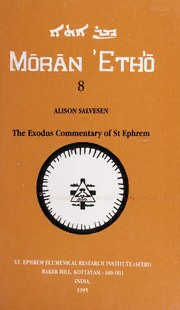
The Exodus Commentary of St. Ephrem PDF
Preview The Exodus Commentary of St. Ephrem
The Exodus Commentary of St Ephrem ST. EPHREM ECUMENICAL RESEARCH INSTITUTE (SEERI) BAKER HILL. KOTTAYAM - 686 001 INDIA. ' 1995 % The Exodus Commentary of St Ephrem The Exodus Commentary of St Ephrem Alison Salvesen St. Ephrem Ecumenical Research Institute(SEERI) Baker Hill, Kottayam - 686 001 Kerala, India. .1995 The Exodus Commentary of St. Ephrem By Alison Salvesen Moran 'Etho Series No.8. Published by: St. Ephrem Ecumenical Research Institute(SEERI) Baker Hill, Kottayam - 686 001 Kerala, India. Printed at: Wigi Offset Printers Manganam P.O., Kottayam - 686 018. Ph : 570862. Fax 91-0481-570862. Introduction Ephrem’s Exodus Commentary probably dates from ;he last decade of his life, a period which he spent in Odessa, having left his native Nisibis along with the rest )f the Christian population when the city was handed >ver to the Persians by the Romans in 363. The term commentary is a little misleading since he text may originate from notes of lectures given by ]phrem in the theological School of Edessa, as in the ase of his Genesis commentary, and Ephrem more or ess retells the Exodus story in his own words. The articular stress on female characters in the narrative - gain, this is a feature in common with the Genesis com- lentary - suggests that Ephrem was aiming his interpre- ation at the “Daughters of the Covenant”, consecrated omen in the Christian community.1 1 See Salvesen, “Ephrem’s Exodus Commentary” and “Some Themes...” (References to relevant modern works generally appear in abbreviated form: full details are given in the Bibliography.) Ephrem’s Exodus Commentary 2 The commentary exists in a single sixth century manuscript incorporating the Genesis commentary as well, and belonging to the Vatican Library. Towards the end of Exodus this manuscript becomes increasingly illegible, and the final sections are missing. The edition used for this translation is Tonneau’s, and I have gener¬ ally followed Jansma’s suggestions for emending the text.2 Tonneau himself produced a Latin translation as a companion volume to his edition, and paul Feghali is responsible for a translation into French. I have been somewhat liberal with my own rendering at times, as a close reproduction of the grammatical niceties of the Syriac text does not do justice to Ephrem’s lively style. Although Ephrem sometimes explains a difficult ph rase in passing, he certainly does not give us a verse by verse commentary of the biblical Exodus. Instead he offers his own interpretation of the narrative, in line with the Syriac title of the work, turgama, or explanation (cf.Jewish Targum, an Aramaic paraphrase of the Bible). It is closer in style to the retellings of the Jewish Greek writers Josephus and Philo than the biblical commentar¬ ies that the modern reader may be familiar with. Such a style enables Ephrem to omit or gloss over certain parts of the biblical narrative while highlighting others. For instance, Moses’ father is never mentioned whereas his mother is brou- ght into prominence, many of the laws are omitted and the details of the building of the Taber¬ nacle are much abbreviated, while the episode at the inn (4.24-26) is expanded and interpreted. 2 In “Some Remarks...” and “Weitere Beitrage...” See Bibliogra¬ phy for details of other authors and works.
